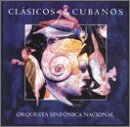| All Artists: Orquesta Sinfónica Nacional Title: Clasicos Cubanos Members Wishing: 0 Total Copies: 0 Label: Egrem Music Cuba Release Date: 5/7/2002 Album Type: Import Genres: International Music, Pop, Classical Styles: Caribbean & Cuba, Cuba, Symphonies Number of Discs: 1 SwapaCD Credits: 1 Other Editions: Clasicos Cubanos UPCs: 076715742320, 8500001614562 |
Search - Orquesta Sinfónica Nacional :: Clasicos Cubanos
 | Orquesta Sinfónica Nacional Clasicos Cubanos Genres: International Music, Pop, Classical
|
Larger Image |
CD Details |
CD ReviewsCuban Classics Kilemyan | Copenhagen, Denmark | 09/01/2008 (5 out of 5 stars) "Cuban Classics is the English title of this brilliant CD from the Cuban Record Company (EGREM). It is also the first volume of four CDs with orchestral works by Cuban composers, but unfortunately the other three volumes are not available outside Cuba (as far as I know).
Cuban Classics, vol. 1 contains orchestral works by four contemporary Cuban composers: Edgardo Martín, Fabio Landa, Alfredo Diez Nieto, and Leo Brouwer. The CD opens with "Soneras No. 1" written by Edgardo Martín (1915-2004) in 1951. Martín was a founding member of the neo-Classicist orientated Grupo de Renovación Musical (1942-48) and was influenced by Bartok, Stravinsky, and Falla, but later he also embraced Cuban popular elements. "Soneras No.1" is a powerful orchestral work in three movements which evokes memories of the past, especially the nationalist composers Caturla and Roldán. Although written in a predominantly nationalist style "Soneras No. 1" employs neo-Classicist procedures. "Pequeña suite cubana" was written by Fabio Landa (1924-2003) in 1951. Landa was also an oustanding conductor and cellist (who also played guitar and piano). This work is also scored in three movements entitled "Habanera", "Afro", and "Ritmo". "Pequeña suite cubana" is a lovely work that reveals the composer's predilection for the French School (the subtitle of the work is "Homenaje a Maurice Ravel"). Landa wrote orchestral works, chamber music, choral pieces, piano music and numerous incidental scores for the cinema, the theatre and the ballet. He was influenced by Impressionism and Romanticism rather than neo-Classicism, but like Martín he also embraced the Cuban folklore. "Sinfonía No.1" was completed in 1943 by Alfredo Diez Nieto (*1918), who was also an outstanding conductor, pianist and professor. He was trained in Cuba and in the United States, and was influenced by Impressionism, Romanticism and Cuban nationalism. His first symphony is a true masterwork, but unfortunately the CD only contains the slowly second movement, but what a magnificient movement!!! Diez Nieto was only 25 years old when he completed this predominantly neo-Romantic Symphony No.1, but it seems like a mature work. The splendid second movement is almost like a concertino for violin solo and string orchestra. Diez Nieto turns 90 this autumn, and I am sure that he and his colleague and friend Harold Gramatges (*1918) will be celebrated in Havana. "Canción de gesta" by Leo Brouwer (*1939) was completed in 1979 after the composer had turned to a post-modern language after more than fifteen years with the Cuban avant-garde movement. Brouwer is a prolific composer and perhaps the most celebrated Cuban composer outside his native island. He was a prominent concert guitarist for twenty five years (1959-84), and since the mid-1980s he has made a career as conductor. "Canción de gesta" (litt. Heroic Song) is dedicated to the 82 rebels on the famous Granma yacht, which brough the revolution to Cuba in 1959. This intriguing piece is almost like a musical parallel to the Latin American literary magic realism (e.g. Alejo Carpentier). Although the piece opens with a brief quotation from Handel's Water Music it is not a collage piece, but belongs to what Brouwer has called his hyper-Romantic period (e.g. post-modernism) in which he blends neo-Romantic and minimalist procedures with new tonal elements. Edgardo Martín, Alfredo Diez Nieto, and Fabio Landa also began employing new techniques in the 1960s, but not as radical as those new techniques employed by Leo Brouwer and his generation. However, the older generation soon abandoned the atonal and serial techniques and returned to a tonal language. Clásicos Cubanos, vol. 1 is a splendid CD, and I really hope EGREM would offer the other three volumes (plus the fine Antología Pianística Cubana, vol. 1 & 2) to amazon.com. " |

 Track Listings (8) - Disc #1
Track Listings (8) - Disc #1